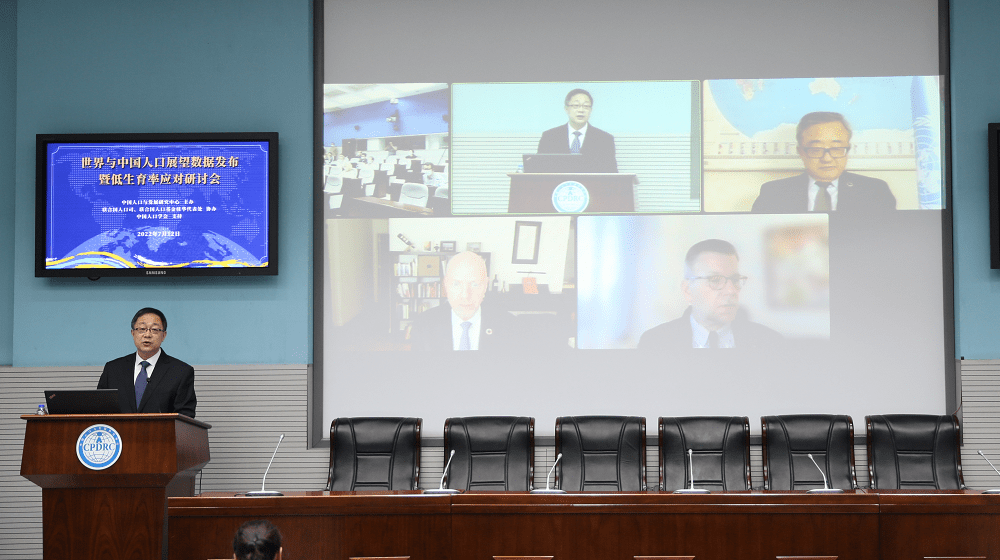BEIJING, China -- The global population is projected to reach 8 billion on 15 November 2022, and India is projected to surpass China as the world’s most populous country in 2023, according to World Population Prospects 2022, released jointly by the Population Division of the United Nations Department of Economic and Social Affairs (UNDESA/Population Division), China Population and Development Research Center (CPDRC) and UNFPA with support of China Population Association online in Beijing on 12 July.
World Population Prospects 2022 is the twenty-seventh edition of the official estimates and projections of the global population that have been published by the United Nations since 1951. They form a comprehensive set of demographic data to assess population trends at the global, regional and national levels. The results of China’ seventh national population census in 2020 contributes to the latest assessment in the report.
“For a long time, the United Nations Economic and Social Council, the Population Division of UNDESA and UNFPA have been supporting developing countries, including China, in population statistics and global cooperation. The World Population Prospects have rich data from over 230 countries and regions. They are significant in understanding the global population changes and promoting the achievement of the Sustainable Development Goals by 2030,” said Mr. Yu Xuejun, Vice Minister of the National Health Commission of China.
The latest projections by the United Nations suggest that the world’s population could grow to around 8.5 billion in 2030 and 9.7 billion in 2050. It is projected to reach a peak of around 10.4 billion people during the 2080s and to remain at that level until 2100.
In addition, World Population Prospects states that demographic diversities across countries are more apparent now than any time in history. Never before in human history have we seen such extreme diversity in the mean age of countries and the fertility rates of populations. While there are countries with youthful populations and growing populations, a growing number of countries face population aging and roughly two-thirds of the global population lives in a country or area where lifetime fertility is below 2.1 births per woman, the level required for zero growth in the long run for a population with low mortality.
“The relationship between population growth and sustainable development is complex and multidimensional,” said Liu Zhenmin, Under-Secretary-General of the UNDESA. “Rapid population growth makes eradicating poverty, combating hunger and malnutrition, and increasing the coverage of health and education systems more difficult. Conversely, achieving the Sustainable Development Goals, especially those related to health, education and gender equality, will contribute to reducing fertility levels and slowing global population growth.”
China, as the world’s most populous country, is undergoing multiple population changes, particularly low fertility and population ageing. According to projections from CPDRC, the country’s population will reach a peak of 1.42 billion and will stay at 1.4 billion by 2035. Its birth rate will remain at a low level with about 10 million annual new births by 2035 or for an even longer term. Its older persons aged 80 and above will double to 79.6 million by 2035, while the working age population will remain at over 90 million by the same period.
“Now, the paradox is that ageing is largely inevitable, but low fertility is a choice. If we are concerned about low fertility and its associated implications, we have to look at policies that affect a woman's reproductive choices. ,” said Mr. Arthur Erken, Director of the Policy and Strategy Division, UNFPA.
UNFPA advocates for countries to build demographic resilience, by meeting the needs of diverse population groups and ensuring that individuals can realize their full potential. “Family-friendly policies are most effective in supporting women’s and men’s fertility choices if they respond to various needs of individuals, foster reconciliation between paid work and childrearing, promote the health and well-being of people as well as provide financial support to families with limited income,” added Mr. Erken.
Speakers presented evidence that the low fertility rate in China is associated with complex factors including the previous policy-driven low fertility advocacy, difficulties with childcare, challenges to balance women’s employment and family life, financial constraints particularly high housing costs, and cultural norms, therefore requiring comprehensive, holistic policy responses that are based on evidence and allow all people to exercise their full range of rights, including reproductive rights. It also noted that there is no single approach that fits all low fertility countries.
“As China is at the forefront of responding to complex demographic changes, its experience sharing will be critical in strengthening collaboration between demographically diverse countries in an increasingly interconnected world. UNFPA has been and will continue to work with China in promoting global cooperation on population and development,” commented Dr. Justine Coulson, Representative of UNFPA in China.
Over 70 people from the UN, China, Australia, US, UK and Japan attended the discussion on population prospects and policy response to low fertility.
- To download World Population Prospects 2022: Summary of Results: https://www.un.org/development/desa/pd/content/World-Population-Prospec…
- To learn more about UNFPA and its programme in China: https://china.unfpa.org/
- For more information, please contact: Ms. Shujun Liu, Communications Analyst, UNFPA China, sliu@unfpa.org


